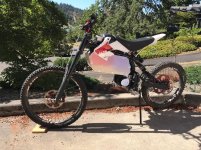LightningRods
1 MW
Are you spinning the wheel with the bike upside down?
LightningRods said:MSF said:That is my bike and the brake works as it should going forward just not backwards. Don't tell me i am the first one to think of this
No, the idea occurred to me as soon as I made the six bolt pattern for the single speed sprocket the same as the brake rotor. Sadly it doesn’t work. What the freewheel/freehub does is allow the wheel to rotate forward when the rider stops pedaling. The rotor behaves the same as the sprocket. It stops and the wheel freewheels.
LightningRods said:Are you spinning the wheel with the bike upside down?
MSF said:the hub was rotated 180 by the way
LightningRods said:54627797-3251-4273-B71B-DFE17E905419.jpeg

Can't wait for the transformation of this week cyclone to the LightningRods Big Block
LightningRods said:I’m ordering 10 small block motors next week. If people want them I’ll buy more. The new IPM version should have the potential to be a high rpm screamer as well as a well behaved 3kW commuter motor.
Perhaps the biggest advantage of IPM designs, one that gives them an edge in vehicle applications like traction motors, is the high-speed performance. The power versus speed curve for SPM motors is roughly hyperbolic, rising to a region of quasi-constant power over a narrow speed range, then falling off.
IPM motors, in contrast, provide a much broader region of more or less consistent torque. Using a technique called field weakening, designers can apply current to modify performance. As speed rises, the permanent magnets and motor generate highers voltage. At very high speeds, the back EMF of the motor times the speed can exceed the voltage of the battery, which limits drive current, and torque. Field weakening essentially involves tuning the magnetic field of the stator to partially oppose the effect of the permanent magnets. The process involves a control scheme known as direct (D) and quadrature (Q) axis current control. The D-axis runs through the center of the rotor pole while the Q-axis lies between two adjacent rotor poles in the center. “By breaking the stator vector into two vectors, and applying one current to the quadrature axis and one to the direct axis, they control the current phase angle between them, which allows much wider constant power control," explains motor designer and IEEE fellow Jim Hendershot, co-author of Permanent Magnet Brushless Motors and Generator Design.
For vehicle applications, the technique provides big benefits compared to SPM motors. “The IPM configuration allows more control over the magnetization of the magnetic circuit," says Hendershot.
That's not to say that field weakening isn't possible with SPM designs, as well, but because of the size of the air gap, the technique requires far higher currents. “Because of the current limit of the inverter on thermal limitations of the motor, you can't field weaken it enough to produce torque at high speeds," says Fulton.
At low speeds, SPM motor and an IPM motor of the same size can generally produce about the same amount torque, or the SPM design may even produce a bit more up until they reach the corner point RPM. At speeds higher than the corner-point RPM, torque from SPM designs drops rapidly. “If both of them have a base of 3000 RPM, the SPM motor will probably have zero torque at 5000 RPM whereas the IPM could continue on to 10,000 or 12,000 RPM," says Fulton. The behavior makes IPM motors a good fit for traction motor applications, which tend to demand high torque over a broad speed range. “With IPM designs you get the best of both worlds—you can get very good acceleration at low speeds and then run at very high speeds while at almost the same power level.”
A type of motor that has a rotor embedded with permanent magnets is called the IPM (interior permanent magnet) type. Compared with the SPM (surface permanent magnet), this type of motor can reduce the risk of a magnet being peeled off by centrifugal force, and take advantage of reluctance torque. The IPM type allows various structures for embedding permanent magnets.

LightningRods said:Left to right- XXL, XL, Big Block center cases
IMG_6217.jpeg
spinningmagnets said:IPM rotors:
Tesla Model-3
Nissan Leaf
Toyota Prius
Zero Motorcycles (all models)
Hybrids and current-gen EV's from Ford, Honda, Lexus, BMW, etc
